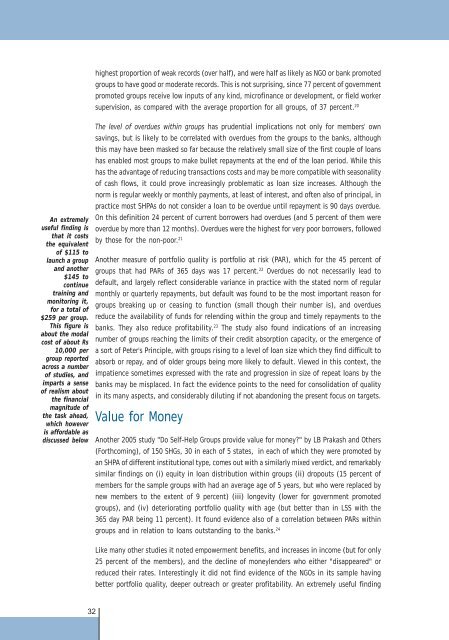Download sector_report1.pdf - Microfinance and Development ...
Download sector_report1.pdf - Microfinance and Development ...
Download sector_report1.pdf - Microfinance and Development ...
You also want an ePaper? Increase the reach of your titles
YUMPU automatically turns print PDFs into web optimized ePapers that Google loves.
highest proportion of weak records (over half), <strong>and</strong> were half as likely as NGO or bank promoted<br />
groups to have good or moderate records. This is not surprising, since 77 percent of government<br />
promoted groups receive low inputs of any kind, microfinance or development, or field worker<br />
supervision, as compared with the average proportion for all groups, of 37 percent. 20<br />
An extremely<br />
useful finding is<br />
that it costs<br />
the equivalent<br />
of $115 to<br />
launch a group<br />
<strong>and</strong> another<br />
$145 to<br />
continue<br />
training <strong>and</strong><br />
monitoring it,<br />
for a total of<br />
$259 per group.<br />
This figure is<br />
about the modal<br />
cost of about Rs<br />
10,000 per<br />
group reported<br />
across a number<br />
of studies, <strong>and</strong><br />
imparts a sense<br />
of realism about<br />
the financial<br />
magnitude of<br />
the task ahead,<br />
which however<br />
is affordable as<br />
discussed below<br />
The level of overdues within groups has prudential implications not only for members' own<br />
savings, but is likely to be correlated with overdues from the groups to the banks, although<br />
this may have been masked so far because the relatively small size of the first couple of loans<br />
has enabled most groups to make bullet repayments at the end of the loan period. While this<br />
has the advantage of reducing transactions costs <strong>and</strong> may be more compatible with seasonality<br />
of cash flows, it could prove increasingly problematic as loan size increases. Although the<br />
norm is regular weekly or monthly payments, at least of interest, <strong>and</strong> often also of principal, in<br />
practice most SHPAs do not consider a loan to be overdue until repayment is 90 days overdue.<br />
On this definition 24 percent of current borrowers had overdues (<strong>and</strong> 5 percent of them were<br />
overdue by more than 12 months). Overdues were the highest for very poor borrowers, followed<br />
by those for the non-poor. 21<br />
Another measure of portfolio quality is portfolio at risk (PAR), which for the 45 percent of<br />
groups that had PARs of 365 days was 17 percent. 22 Overdues do not necessarily lead to<br />
default, <strong>and</strong> largely reflect considerable variance in practice with the stated norm of regular<br />
monthly or quarterly repayments, but default was found to be the most important reason for<br />
groups breaking up or ceasing to function (small though their number is), <strong>and</strong> overdues<br />
reduce the availability of funds for relending within the group <strong>and</strong> timely repayments to the<br />
banks. They also reduce profitability. 23 The study also found indications of an increasing<br />
number of groups reaching the limits of their credit absorption capacity, or the emergence of<br />
a sort of Peter's Principle, with groups rising to a level of loan size which they find difficult to<br />
absorb or repay, <strong>and</strong> of older groups being more likely to default. Viewed in this context, the<br />
impatience sometimes expressed with the rate <strong>and</strong> progression in size of repeat loans by the<br />
banks may be misplaced. In fact the evidence points to the need for consolidation of quality<br />
in its many aspects, <strong>and</strong> considerably diluting if not ab<strong>and</strong>oning the present focus on targets.<br />
Value for Money<br />
Another 2005 study "Do Self-Help Groups provide value for money" by LB Prakash <strong>and</strong> Others<br />
(Forthcoming), of 150 SHGs, 30 in each of 5 states, in each of which they were promoted by<br />
an SHPA of different institutional type, comes out with a similarly mixed verdict, <strong>and</strong> remarkably<br />
similar findings on (i) equity in loan distribution within groups (ii) dropouts (15 percent of<br />
members for the sample groups with had an average age of 5 years, but who were replaced by<br />
new members to the extent of 9 percent) (iii) longevity (lower for government promoted<br />
groups), <strong>and</strong> (iv) deteriorating portfolio quality with age (but better than in LSS with the<br />
365 day PAR being 11 percent). It found evidence also of a correlation between PARs within<br />
groups <strong>and</strong> in relation to loans outst<strong>and</strong>ing to the banks. 24<br />
Like many other studies it noted empowerment benefits, <strong>and</strong> increases in income (but for only<br />
25 percent of the members), <strong>and</strong> the decline of moneylenders who either "disappeared" or<br />
reduced their rates. Interestingly it did not find evidence of the NGOs in its sample having<br />
better portfolio quality, deeper outreach or greater profitability. An extremely useful finding<br />
32














